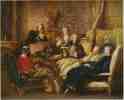
Troy, Jean-François de
(baptized Jan. 27, 1679, Paris--d. Jan. 26, 1752, Rome)
French Rococo painter and tapestry designer
known for his tableaux de mode, or scenes of
the life of the French upper class and aristocracy, especially during
the period of the regency; e.g., "Hunt Breakfast" (1737; Wallace
Collection, London) and "Luncheon with Oysters" (1735; Musée Condé,
Chantilly, Fr.).
His successful career was based
initially on large historical and allegorical compositions
(Time Unveiling Truth, National Gallery, London, 1733),
but he is now most highly regarded for his smaller and more spirited
scenes of elegant social life. They are among the best of those that
rode on the wave of
Watteau's
success--indeed The Alarm (Victoria and Albert Museum, London, 1723)
was attributed to Watteau in the 19th century. In 1738 he was appointed
Director of the French Academy in Rome, and spent the rest of his life
there. He was one of a family of painters, his father and teacher,
François de Troy (1645-1730), being a successful painter
of fashionable portraits and Director of the Academy in Paris.
There were many painters in the de Troy family, including
- Antoine [Toulouse 1608 - id 1684]
-
became painter of his birthplace town hall, where he opened a painting
school. He is attributed a portrait of Pierre Goudelin
(Toulouse).
- Jean III [Toulouse 1638 - Montpellier 1691]
-
Antoine's son. Disciple of his father and Antoine Durand, he made
a visit to Rome. Badly welcomed in Toulouse when he returned, he
decided to move to Montpellier, where he founded an academy (1679-1690).
Among his portraits:
- J.L. Fontanilles (Toulouse)
- La Marquise de Castries (Montpellier)
- Madame de Mondonville
- François [Toulouse 1645 - Paris 1730]
-
Jean's brother. Disciple of his father, then of Loir and C. Lefebvre, he
made his career in Paris, entered the Academie de Peinture (1674), became
its director (1708) and rector (1722).
He was a famous portraitist, either of the crown:
- la Duchesse d'Orleans [Versailles]
- la Duchesse de Bourgogne [Moscou]
- la Duchesse du Maine [Orleans]
- la Duchesse de la Force [Rouen]
or of artists:
- le Joueur de luth Mouton [Louvre]
- Mansart [Versailles]
- Mezzetin [Comedie Française]
He also painted many crossdressed portraits (Venus et Adonis
[Louvre])
- Jean François [Paris 1679 - Rome 1752]
-
François' son. Disciple of his father, he lived in Rome (1698-1704 approx.)
where he made paintings relative to l'Histoire d'Esther
[Louvre, Beaune], along with Jason et Medee, which were
translated into tapestry in the Gobelins.
Member of the Academie de Peinture in 1708, he was director of the
French Academy in Rome, from 1738 to his death. He was mainly a history
painter, with, among his works:
- Bethsabee au bain [Leningrad, Stuttgart]
- l'Enlevement des Sabines [Neuchatel]
- la Continence de Scipion [Neuchatel]
- le Chapitre de l'ordre du Saint-Esprit reuni par Henri IV
[Louvre]
(aussi peintre de genre: Dejeuner d'huitres [Chantilly])
 Reading from Molière
Reading from Molière
around 1728, Oil on canvas, 72.4 x 90.8 cm;
Collection Marchioness of Cholmondeley
© 14 Oct 2002,
Nicolas Pioch -
Top -
Up -
Info
Thanks to the BMW Foundation, the WebMuseum
mirrors,
partners and contributors
for their support.
![]()
 Reading from Molière
Reading from Molière